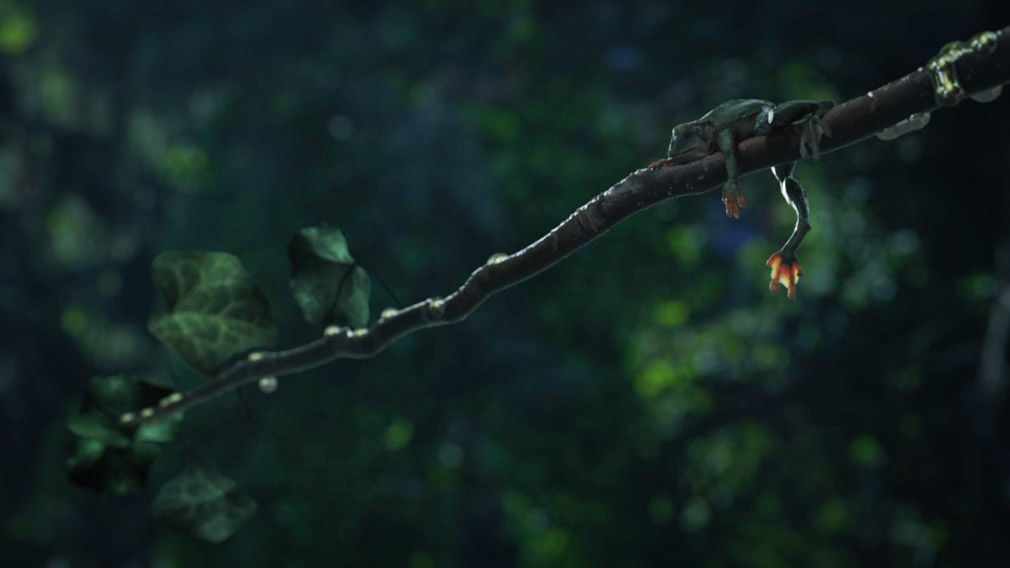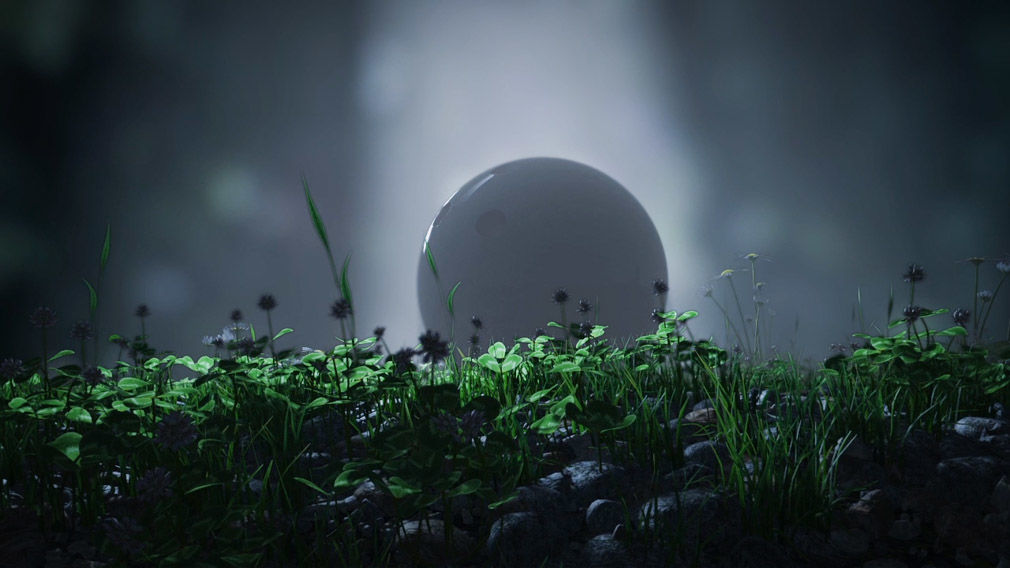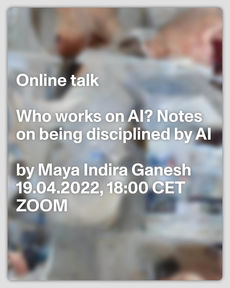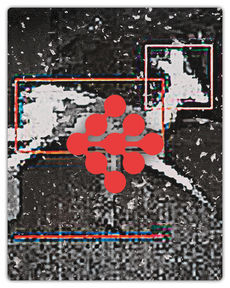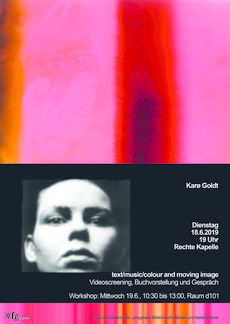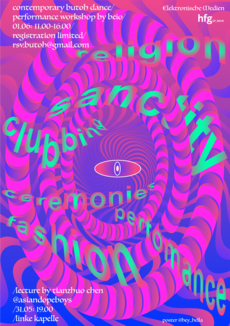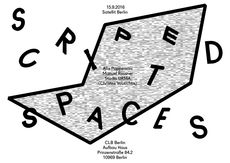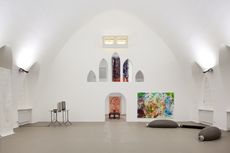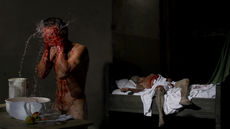Electronic Media
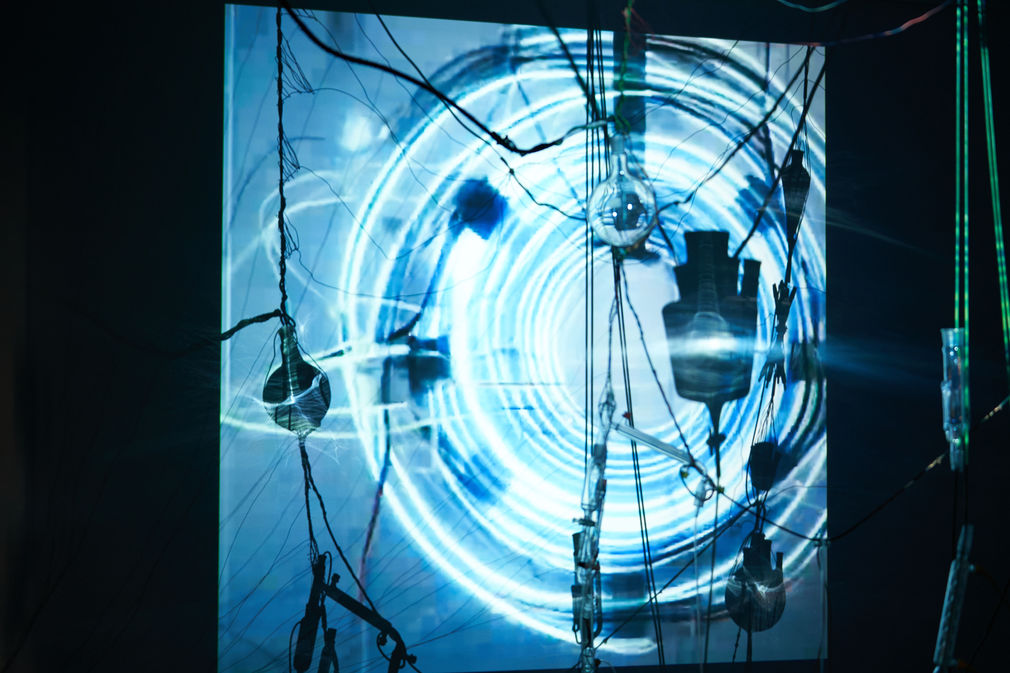
"Sify" Elisa Deutfloff, 2023
Credit: Jakob Diekmann
As a field of teaching, Electronic Media not only involves the aesthetic but also the technical analysis of artistic and applied issues and project developments in relation to electronic media. This field of teaching covers both the development of specific media applications and basic media research.
The focus is on the artistic handling of films, videos, computers and installations in their diverse forms: video installations and video sculpture, sound machines and audio art, computer art, computer graphics, digital image simulation and animation. The aim is for students to develop their own artistic position, to critically analyze the topic of media and mass culture and find an artistic response to it.
At HfG Offenbach we explore and seek to advance the aesthetic innovative energy of new media, their potential for future forms of graphics, painting, sculpture and installation, stage design, film and movement simulation as well as for design and the public. This is done in a conscious dialog with traditional artistic media and not in an overly technical, self-referential manner. This linking with traditional media is realized among other things in video and spatial installations, animations or sculptures. Workshops, technical courses, guest contributions and collaborations serve to complement the instruction in Electronic Media.
-
Prof. Alexander Oppermann
T +49 (0)69.800 59-220
West wing, room D101
Natalie Wilke
Research Associate
T 49 (0)69.800 59-311
Westflügel, Raum D101
Barbara Leonardi
Research Associate
Head E-Medien-Lab
leonardi@hfg-offenbach.de
T +49 (0)69.800 59-310
Westwing, Room D101
Evgenia Rzheznikova
Research Associate
Westwing, Room D101
Consultation
by appointment
KI-Labor
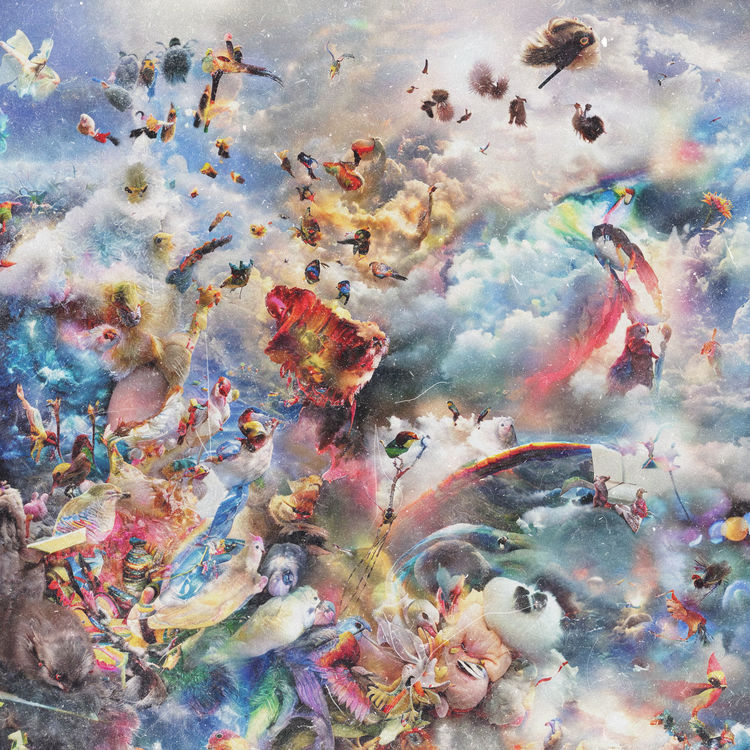
Malik Arbab, 2022
The AI Lab allows students to develop their own Deep Learning algorithms that match their aesthetic vision or to integrate existing datasets and trained models into their artistic practice. It serves as a dynamic forum for reflecting on the impact of technology on society and artistic creation, including ethical challenges related to AI. At the same time, the lab strongly focuses on understanding how current algorithms work to foster informed and critical engagement with the field. more
KI-Labor
Leon Etienne Kühr
Research Associate
Co-Lead AI Lab
kuehr@hfg-offenbach.de
Westwing, Room 307
Mattis Kuhn
Research Associate
Co-Lead AI Lab
kuhn@hfg-offenbach.de
Westwing, Room 307
Algorithms in Context
Johanna Teresa Wallenborn
Wissenschaftliche Mitarbeiterin
T +49 (0)69.800 59-220
Student assistants:
Elisa Deutloff, Maximilian Kreis
http://aic.hfg-offenbach.de/
Algorithms in Context Social Media
Robotic Lab
The Robotics Lab is part of the Electronic Media Department within the Faculty of Art. It supports students in developing interactive installations using physical computing, robotics, digital fabrication and artificial intelligence. The courses and workshops offered by the Robotics Lab aim to teach students methods and processes for realising interactive installations based on computer vision models and algorithms. This will enable them to create works that bridge the virtual and physical worlds. Computer vision is a field of artificial intelligence that allows computers to interpret and understand visual information in a similar way to humans. It includes methods of image and video analysis, as well as object recognition and tracking.
More
-
Barbara Leonardi
T +49 (0)69.800 59-310
West wing, room D101
-
Evgenia Rzheznikova
T +49 (0)69.800 59-353
West wing, room D101
Sound
The electronic media recording studio supports sound projects of all kinds, offering the unique opportunity to work at a professional monitoring station with a full range of analogue and digital equipment. The studio's primary focus is on sound design and acoustically functional, focused studio work. Bastian Kämmer and Phil Hoffart provide comprehensive introductions to the studio for independent use, in-depth workshops on sound design, mixing, mastering and recording, and expert advice on production issues, through to translation to the club system.
In her seminar, "What's Your Set Up," Charlotte Simon focuses on the practical aspects of sound in the context of project-based work. The course covers live performance in its various forms across different contexts and genres, delving into technical and content-related aspects, as well as rehearsals and presentations. The curriculum is organized around a different focus each semester: sound productions for dance on the theatre stages of Studio Naxos, computer music as a collective jam in the exhibition context Rundgang and as a cassette release, choirs, saxophones and DJ modular system hybrids in the techno club, urban sound installations for park and ship at the pop culture festival Rivera. In addition to practical artistic work, students develop an understanding of the technical aspects of sound, including digital audio production, analogue recording and sound technology, as well as analogue sound synthesis. The workshops examine the entire spectrum of sound, encompassing both theoretical and practical aspects. The seminars are complemented by theoretical excursions on pioneers of electronic music, the role of sound in public spaces, experimental club music, noise, and other related topics.

Charlotte Simon
Bastian Kämmer
Phil Hoffart
Lehrbeauftragte
Projects

Digitale Perspektiven in der Kunst
Das Projekt „Digitale Perspektiven in der Kunst“ ist ein Kooperationsprojekt zwischen der HfG Offenbach, HFMDK Frankfurt, Kunsthochschule Kassel und Städelschule, gefördert durch das Hessisches Ministerium für Wissenschaft und Forschung, Kunst und Kultur. Das Projekt „Digitale Perspektiven in der Kunst“ ist ein Kooperationsprojekt zwischen der HFG- Offenbach, HFMDK- Frankfurt, Kunsthochschule Kassel und Städelschule, gefördert durch das Hessisches Ministerium für Wissenschaft und Forschung, Kunst und Kultur.
Alle Beiträge
RAISE (Research on Artificial Intelligence aand musical Expression)
The RAISE research project explored the interactions and relationships between artificial intelligence (AI), sound, and musical expression with the goal to make AI-based technologies accessible and usable for sound creators of various competency levels particularly those with little or no prior knowledge of machine learning or programming, The project was funded by Hessian.AI.

Künstlerische Projekte

Chelsea Hartmann, r3s0n4nce (2024)
3D-Scan/Pointcloud, Soundreactive Animation
3D-Scans urbaner Szenerien aus Offenbach, Berlin und albanischen Kleinstädten in audioreaktiver Manipulation. Pointclouds, generiert aus den LIDAR-Daten der 3D-Scans, werden durch den abstrakten Einfluss von Sound verfremdet. Das Werk erforscht den Schnittpunkt von Architektur, Technologie und Musik. Eine visuelle Programmiersoftware verknüpft Audioparameter wie Bass, Tonhöhe und Rhythmus mit den Tiefeninformationen der 3D-Modelle. Im Verlauf des Videos verstärkt sich die klangliche Verzerrung der Aufnahmen, was die Wahrnehmung des Verhältnisses von Materie und Klang herausfordert.

Yihan Shiau, Excalibur (2024)
Mixed Media, Sound Installation, PLA, Isomalt, Resin
Weapons are instruments of fear, all creatures hate them.
When many people are being killed, they should be mourned in heartfelt sorrow.
This is why a victory must be observed like a funeral.

Vincent Weil, mys(h)elf (2024)
Video, Animation, Holz, Bauschaum, Epoxidharz
Meine Arbeit befasst sich mit Gedanken und Gefühlen, die ich in letzter Zeit habe. Ich zeige mehrere kleine Arbeiten von mir in einer Videocollage auf einem Fernseher, der auf einem Regal steht, welches ich basierend auf einem 3D-Scan meines Regals mit persönlichen Gegenständen nachgebaut habe. So soll ein sehr persönlichen Einblick auf mein Leben entstehen und Themen wie Liebe, Fernweh, Nostalgie und Kurzlebigkeit behandelt werden.


Valentin Oellers, Wenn Frösche Fliegen lernen (2014)
CGI Animation, Länge 3:00 min
Der immerwährende archetypische Kampf zwischen Fröschen und Fliegen dreht sich doch nur im Kreis, wenn man mal genau hinsieht. Kurz gesagt: das Leben, und die damit einhergehenden Probleme können ein großes Laster sein. So scheint doch ein Leben nach dem Hier und Jetzt, eine Erlösung zu sein, doch ob es so ist, weiß selbst ein Frosch nicht.
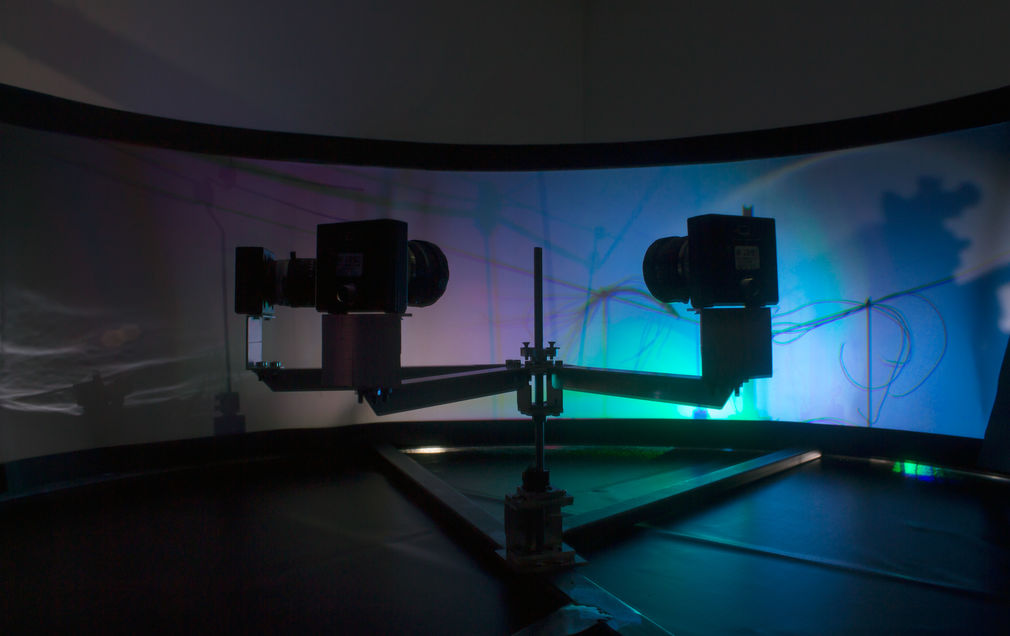
Lichtmaschine (2014)
3 Videokameras, 6 Video-Projektoren, 2 Computer, 8 Arduinos, Motoren, Leuchtdioden, Kinetische Installation von Tilmann Aechtner, Yoonsun Kim, Carolin Liebl, Nikolas Schmid-Pfähler
Die kinetische Skulptur »Lichtmaschine« wurde im Rahmen der Luminale 2014 entwickelt. Die Maschine besteht aus einem komplexen Aufbau aus Leinwänden, kinetischen Objekten, Leuchtdioden und Videokameras. Um die kreisförmig angeordneten Leinwände sind viele kleine, bewegliche und unbewegliche Objekte positioniert, die von Motoren angetrieben und durch LED-Leuchten bestrahlt Schattenbilder und Lichtspiele auf die umliegenden Leinwände werfen. Im Inneren des Leinwandkreises zeichnen Kameras die produzierten Bilder der Objekte auf, die wiederum auf im Raum positionierte große Leinwände projiziert werden.
»Lichtmaschine« spielt mit den unmittelbaren atmosphärischen (Raum-)Erfahrungen, den Methoden der Bildproduktion und dem Wechselspiel zwischen realen und digitalen Bildern und thematisiert somit das Sehen und Wahrnehmen sowie Prozesse des Beobachtens und Erkennens.
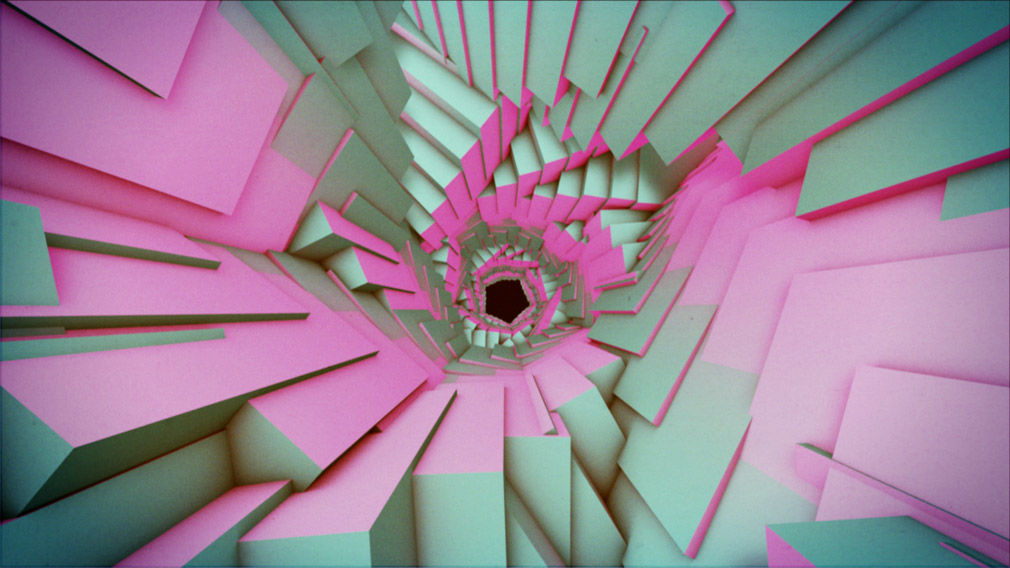
Ni
Music video
Das experimentelle Musikvideo für Sergej Autos »Ni« spielt in einer einfachen grafischen Welt. Es untersucht die assoziativen Beziehungen zwischen Raum, Form und Musik. Durch ihren hypnotischen Sog ziehen die komplexen architektonischen Gebilde den Betrachter immer mehr in ihren Bann.
...
HfG Website Redesign
Project team
Mathias Bär
Manuel Roßner
Anna Skopp
Julia Zuleger
Counselling professor
Studying at HfG Offenbach provides an opportunity for an exchange of ideas and opinions between lots of different creative and theoretical disciplines in the fields of visual communication and product design.
The aim behind relaunching the website was to develop a concept with a visual thrust that does not overly emphasize any one particular area of study nor rely on a non-moving structure.
Layout concept
Teachers and students alike shape the face of HfG through their work, while the university provides a setting in which they can develop themselves freely.
With this in mind a design was evolved whereby the content has a decisive influence on the website’s appearance. There were no rigid layout criteria set to which content then had to be adapted. Individual objects are arranged continually in a pattern. The width of the browser determines how pages are made up and how white spaces are formed. This means an individual image is automatically created for every page and every screen width.
Design elements
The line is the expressive element that all HfG disciplines have in common. As a design tool it is key to the website’s design concept. In its role as a designator, it structures the content and helps users navigate the site. Chance errors and irregularities lend it an individual character.
The line is transformed from a purely functional object into an independent form, which shapes the look of the HfG website.
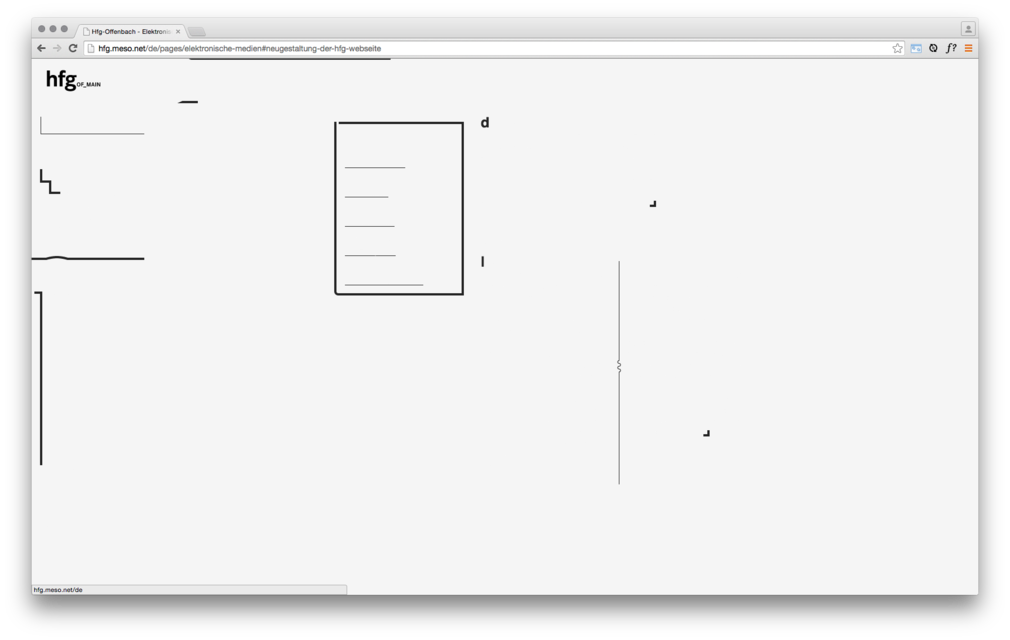
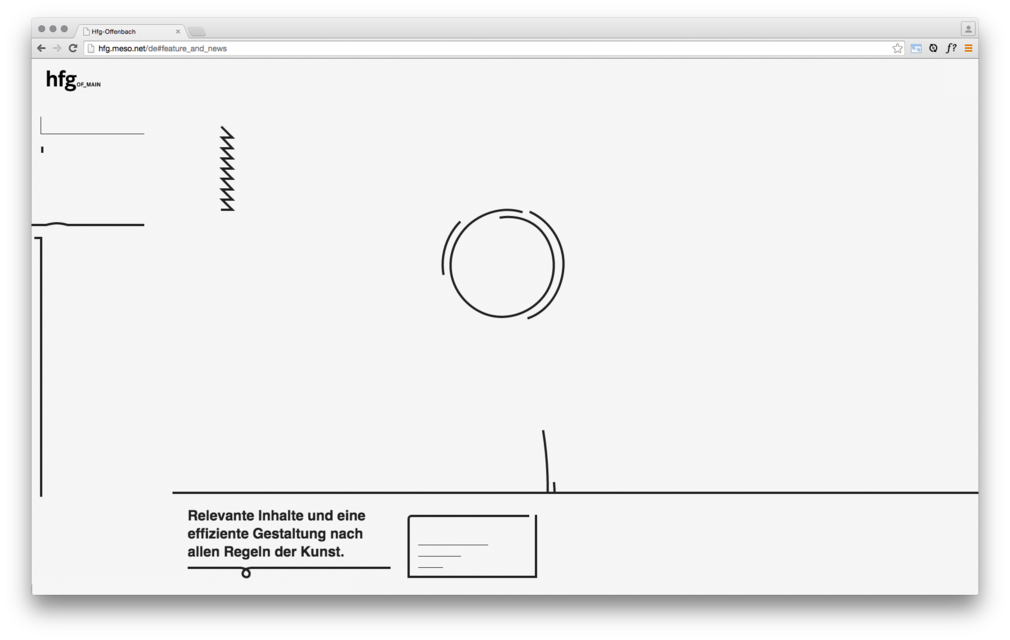
Calendar
14 February 2015 until 19 April 2022Text/music/colour and moving image
until 19 JuneMonitoring – Selected
until 14 MarchNews
New HfG Offenbach Website
The new HfG Offenbach Wesbsite went online
HfG showing at the 65th Berlin International Film Festival
Once again HfG Offenbach will present at the 65th Berlin International Film Festival (February 5-15, 2015) with productions by and involving our students.
